Art & Exhibitions
Jeff Koons as the Art World’s Great White Hope
The Whitney retrospective reveals an unexpected obsession in his work.
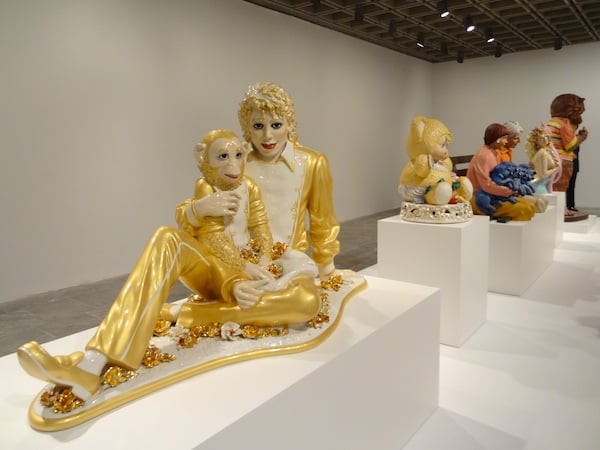
Photo: Benjamin Sutton.
The Whitney retrospective reveals an unexpected obsession in his work.

by
Ben Davis

Midway through the Whitney Museum’s Jeff Koons retrospective, you come upon “Banality.” The series, unveiled in 1988 at three galleries concurrently (Sonnabend in New York, Donald Young in Chicago, and Max Hetzler in Cologne), made Koons the neo-Pop god that he is today. It consists of a series of man-sized kitsch figurines.
“In my ‘Banality’ series I started to focus on my dialogue about people accepting their own histories,” he said later. “I was just trying to say that whatever you respond to is perfect, that your history and your own cultural background are perfect.” This is typical of Koons’s self-help-ish patter of positivity, though also actually sharper than most of Koons’s pronouncements in acknowledging that there are other cultural backgrounds.
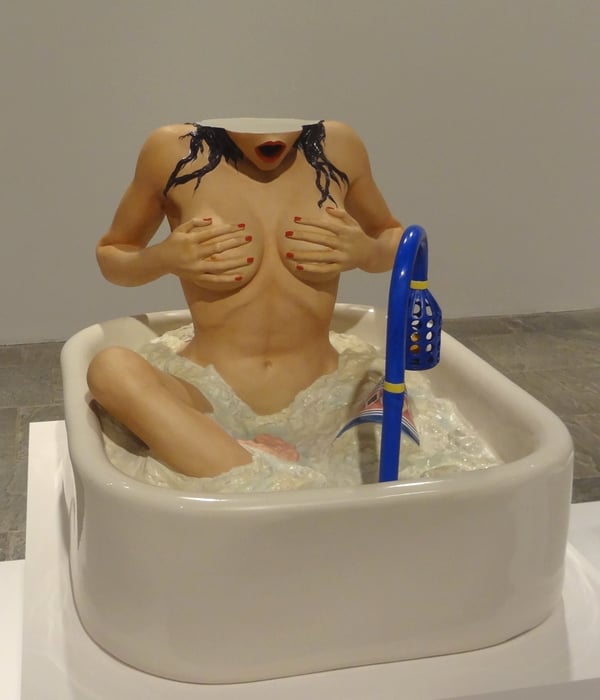
Jeff Koons, Woman in Tub (1988), from the “Banality” series.
Photo: Benjamin Sutton.
At the dead center of “Banality” is Michael Jackson and Bubbles (1988), the most well-known of these well-known sculptures, a pietà-inspired homage to the King of Pop and his favorite monkey, in gilded porcelain. A wall label at the Whitney explains the significance of the piece for Koons. It reads, in part:
When the work was made, Jackson was arguably the most famous entertainer in the world and Koons admired him as the epitome of mainstream appeal, just as the artist’s own celebrity was reaching new heights. “If I could be one other living person,” Koons remarked at the time, “it would probably be Michael Jackson.” Koons praised Jackson as someone willing to do “absolutely anything to be able to communicate with people.” In Koons’s eyes this included plastic surgery and skin-lightening procedures that he claimed Jackson undertook to reach more middle-class white audiences. “That’s radicality. That’s abstraction,” Koons said.
You read that and you say, wait… what? Is that the Whitney praising Koons praising Michael Jackson for becoming white as the ultimate act of artistry?
Facepalm.
And suddenly Koons’s populist shtick looks very different.
Koons’ Take on Cultural Pluralism
It is actually a virtue of this large, polished Scott Rothkopf-curated show that it adds complexity to the story of how Koons arrived at that shtick, though the exhibition is too preoccupied with arguing for his status as The Great Artist of Our Time to do anything with the potential insight. Down on the second floor, you get to peruse Koons’s earliest works, the first examples hailing from 1979. That year also happens to be when the term “postmodernism” entered consciousness, with the publication of Jean-François Lyotard’s The Postmodern Condition. Universalizing narratives were in flux. The civil rights, feminist, and gay rights movements of the 60s and 70s cast long shadows. New York was bumbling its way through economic calamity and building up to the yuppie, Wall Street 1980s. Everything was covered with graffiti, including the art world, which was engaged in its exoticizing love affair with urban art. The scene when Koons hit town, Rothkopf reminds us, “was awash with pluralism.”
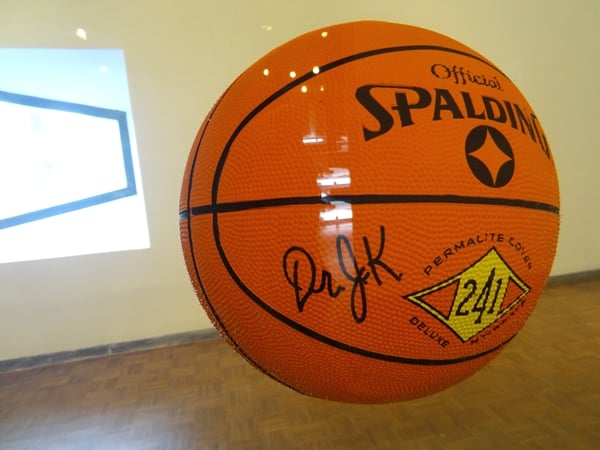
Detail of Jeff Koons, One Ball Total Equilibrium Tank (Spalding Dr. J Series) (1985).
Photo: Benjamin Sutton.
And so cultural pluralism was the background context for Koons’s early explorations of his big theme: “taste.” Most Koons fans know his early-career sculptures incorporating basketballs floating in dream-like stasis in tanks of clear water, originally seen in his “Equilibrium” show at the scrappy East Village space International With Monument, in 1985. I had always accepted the line that they were an ironic homage to the perfection of the commodity. But why basketballs?
What I had not quite realized, until this show, is how racially charged this signifier was. At the Whitney, the tanks are shown surrounded by slick Nike posters, all featuring black basketball players. Koons, we are told, viewed the athletes as “‘sirens beckoning young people (especially African Americans) with the promise of social mobility.” You read that right: “Equilibrium” is a commentary on black culture.
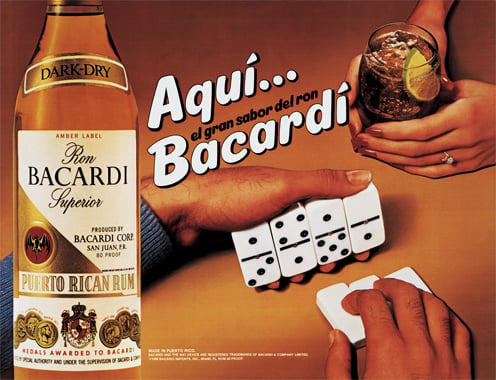
Jeff Koons, Aqui Bacardi (1986)
Photo: Ben Davis
If that sounds like a stretch, Koons’s next body of work, 1986’s “Luxury and Degradation,” was quite explicitly about how taste is framed by race and class. It includes a series of appropriated liquor ads, shown at painting size. While they have common tropes—basically, liquor leads to sex—the details are different: Aqui Bacardi features the tagline “El gran sabor del ron” with an image of a man’s hands playing dominoes opposite a woman’s hands gripping a glass of rum; Hennessy, The Civilized Way to Lay Down the Law shows an African-American couple in a study, sharing an intimate moment over snifters of cognac.
Crucially, for the more deluxe brands, the come-on is more indirect, more sophisticated: an ad for Frangelico features a ribbon of the caramel-colored liquid and the tagline, “Stay in tonight.” The critical point here is, in effect, the same one Koons later imputed uncritically to the Michael Jackson work: reaching the affluent white audience involves notching up the degree of cultural “abstraction.”
These works at least nod to questions of privilege. They suggest thoughts, however unformed, about who culture is aimed at and how desire is constructed. But realizing the specific racial and class components of one’s own taste also means some degree of self-doubt, and self-doubt is exactly what is purged as time goes by and Koons becomes a bigger deal. As David Zwirner explained of Koons not that long ago: “He says if you’re critical, you’re already out of the game.”

Jeff Koons, Cat on a Clothesline (Aqua) (1994–2001).
Photo: Benjamin Sutton.
The fourth, climactic floor of the Whitney is dedicated to shiny, classic-contemporary Koons: the giant, luminously perfect Hanging Heart, a sculpture of a heart-shaped charm; a giant, polished metal balloon dog; a giant sculpture of an adorable kitten in a sock; a giant, newly made, meticulously exact piece resembling clumps of multicolored Play-Doh, mashed together. Did I mention that these works are giant? Any sense of the relativity, and consequent modesty, of one’s taste is gone.
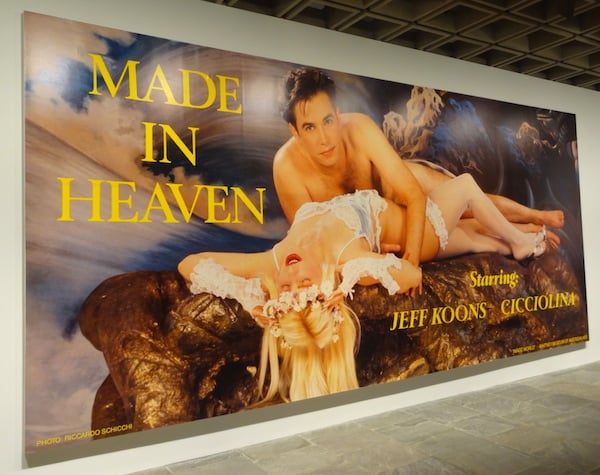
Jeff Koons, Made in Heaven (1989).
Photo: Benjamin Sutton.
I’ve focused on Koons and race, because that’s the revelation of this show for me. You could tell a similar story about gender: In fact, the normal story of Koons’s turn towards super-scaled kitsch objects is how they represented a comeback after the disaster of his pornographic “Made in Heaven” works of 1989—occupying a big section of the Whitney’s third floor, in all their groaty glory—which didn’t sell and were slammed as a sexist celebration of straight male hubris. He claimed to intend them as a universal, missionary statement about embracing your desires (“If you look at Ilona’s ass, there are pimples on it, and there’s a sense of humanity in that, and oneness with the world and with nature,” he said of one particularly graphic work). The public looked at them and basically said, “Your desire is gross to me.”
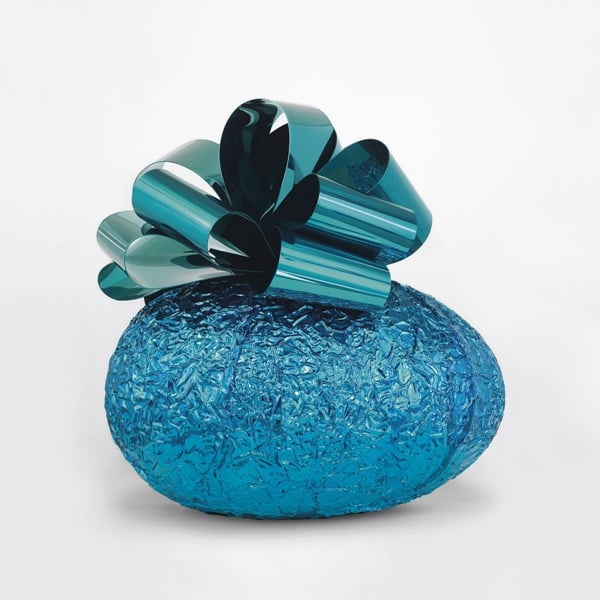
Jeff Koons, Baroque Egg with Bow (1994-2008).
Photo: jeffkoons.com © Jeff Koons.
The “Celebration” works that ensued—massive, shiny playthings—turbo-charged the “Banality” series’s message of cultural “self-acceptance,” and this served to dissolve the criticism: Their subject matter is so programmatically jejune that they are almost impossible to criticize without coming across as being against joy itself. It is pretty much exactly like trying to apply your powers of critique to an internet cat video. Koons, through this dippy populism, successfully recovered the confidence of speaking for the universal, exorcizing the ghost of the pluralist 1980s, a time when even he was fleetingly thinking critically about his own position in the world.
Today, Jeff Koons dominates the center of the art conversation as no one else does. His ideas about turning off your critical mind so infuse the system that the Whitney repeats his bizarre, tone-deaf thoughts about race without even seeming to find them that troubling. Which shows that his universal shtick is an illusion: He speaks both to and from a specific place, and it’s dangerous to forget that.
“Jeff Koons: A Retrospective” is on view at the Whitney Museum of American Art, June 27–October 29, 2014.